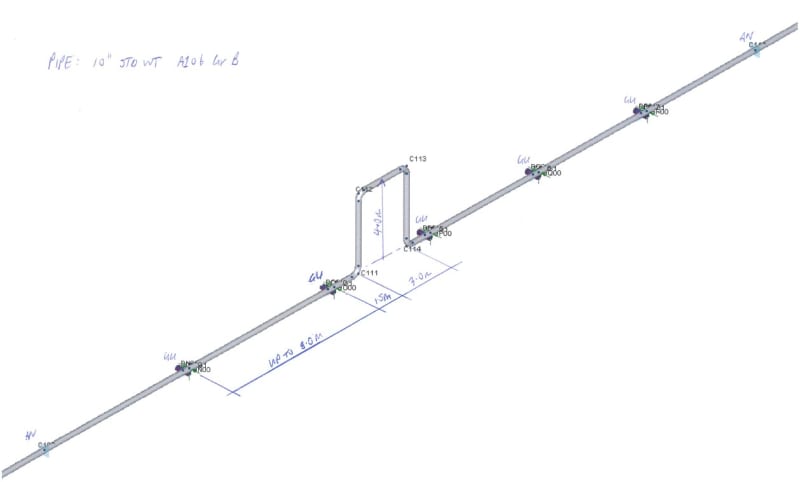Hi, I have been visiting these forums for a while and have learned a lot of good stuff, thank you. Now time for a question:
We have a design for 10” carbon steel pressure piping (ASME B31.1). The pipe has a long straight section near ground level, with a series of vertical expansion loops (4m tall) due to space constraints. Half-way between each expansion loop is an anchor. The other pipe supports are v-stop/guides. Pipe shoes are welded to the bottom of the pipe (inverted T type with end plates). The loops themselves are not supported (except for supports immediately either side of the vertical loop).
The pipe stress analysis (AutoPipe) shows no issues though deflections at the top of the loops are around 100mm in a seismic event acting perpendicular to the general pipe direction.
However, on further thought this is a bit too simple:
1. The Autopipe model assumes that if the vertical loop deflects (i.e due to wind, earthquake) then the straight runs of pipe can twist – with maximum twist at the bottom of the loop and of course working down to zero at the anchor.
2. The pipe support shoe has a flat base with the assumption that the pipe does not axially twist
3. In designing the shoe and shoe/ pipe interface we would typically consider vertical forces acting through the pipe centreline but under the conditions described here, this is not the case
4. Deflection in an under-designed shoe flange can result with possible fatigue implications
I am no Autopipe expert but as far as I can see there is no way to restrict/ restrain torsion in non-anchor supports? I tried a bodge in the model to eliminate torsion in the straight run, and although the stress at the lower elbows of the vertical loops were higher, they were still well within limits. So miss-modelled pipe torsion in itself does not appear to be an issue.
I have scoured the internet for similar examples but I come up empty handed. Even if an unsupported vertical expansion loop is simply a bad idea, there must be loads of other instances in piping design where pipe torsion is an issue, even if just for the support shoe design. Can anyone shed some more light on this? Or is it pretty much a case of: The pipe stress model is by its nature just a model and it is up to the experienced pipe stress engineer to recognise issues such as this and either design out the problem or find another way to manage it/ prove that it is OK?
Thanks for your help.
We have a design for 10” carbon steel pressure piping (ASME B31.1). The pipe has a long straight section near ground level, with a series of vertical expansion loops (4m tall) due to space constraints. Half-way between each expansion loop is an anchor. The other pipe supports are v-stop/guides. Pipe shoes are welded to the bottom of the pipe (inverted T type with end plates). The loops themselves are not supported (except for supports immediately either side of the vertical loop).
The pipe stress analysis (AutoPipe) shows no issues though deflections at the top of the loops are around 100mm in a seismic event acting perpendicular to the general pipe direction.
However, on further thought this is a bit too simple:
1. The Autopipe model assumes that if the vertical loop deflects (i.e due to wind, earthquake) then the straight runs of pipe can twist – with maximum twist at the bottom of the loop and of course working down to zero at the anchor.
2. The pipe support shoe has a flat base with the assumption that the pipe does not axially twist
3. In designing the shoe and shoe/ pipe interface we would typically consider vertical forces acting through the pipe centreline but under the conditions described here, this is not the case
4. Deflection in an under-designed shoe flange can result with possible fatigue implications
I am no Autopipe expert but as far as I can see there is no way to restrict/ restrain torsion in non-anchor supports? I tried a bodge in the model to eliminate torsion in the straight run, and although the stress at the lower elbows of the vertical loops were higher, they were still well within limits. So miss-modelled pipe torsion in itself does not appear to be an issue.
I have scoured the internet for similar examples but I come up empty handed. Even if an unsupported vertical expansion loop is simply a bad idea, there must be loads of other instances in piping design where pipe torsion is an issue, even if just for the support shoe design. Can anyone shed some more light on this? Or is it pretty much a case of: The pipe stress model is by its nature just a model and it is up to the experienced pipe stress engineer to recognise issues such as this and either design out the problem or find another way to manage it/ prove that it is OK?
Thanks for your help.

